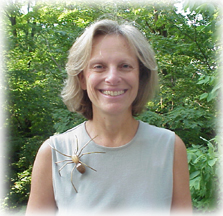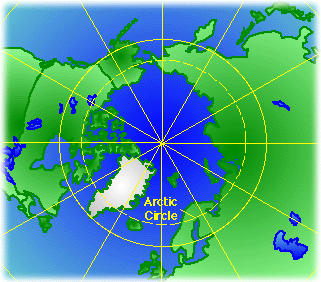
|


Betty's 2004 Arctic Experience I will be joining Dr. Jackie Grebmeier, from the University of Tennessee, and her team onthe Canadian icehreaker, Sir Wilfrid Laurier. We will sail from Kodiak, Alaska on July 7, and travel through the Bering Strait and the Chukchi Sea to Barrow, where we will arrive on July 22. The project is a continuation of Dr. Grebmeier's on-going work on benthic (bottom dwelling) organism and sediments. We will collectdata in order to assess the biological productivity of these organisms which are an important food source for bearded seal,walruses, diving ducks, and gray whales.
The Shelf-Basin Initiative (SBI)
Dr. Jackie
Grebmeier I am extremely excited to be a part of the second phase of a three-phase interdisciplinary research project, the Shelf-Basin Initiative (SBI). The ocean shelf is the gentling sloping submerged area just off the coast, and the basin is the deep part of the ocean. Work on the SBI project is focused on the western Arctic Ocean in the Chukchi and Beaufort Seas. On July 13, I will leave for Nome, Alaska to board the USCGC (United States Coast Guard Cutter) Healy, departing Nome on July 15 to travel through Bering Strait and into the Chukchi and Beaufort seas of the Arctic Ocean. We will return to Nome on August 26. While on board I will be on duty twelve hours a day, seven days a week, primarily assisting with biological sampling. Many models of global climate indicate that global climate change will likely be most prominent in polar regions, and the impact of global warming will be greatest in the Arctic. There is evidence that points to significant terrestrial (land) and marine (ocean) changes that are already occurring. Recent research shows decreased sea ice cover and ice thickness, and increased water and air temperatures. The project goals of the SBI Initiative are to evaluate how projected global changes in temperature, sea ice coverage, and oceanographic processes may influence the exchange of materials between arctic shelves and deep water basins, and what larger impact these changes will have on Arctic communities specifically and human society in general. The scientists involved in the SBI Project hope to understand the physical, biological, geological and chemical aspects of the current system in order to predict the impact of likely global change. The interdisciplinary data gathered will be synthesized in order to develop a realistic ecosystem model in which global change can be tested. Thirty-five scientists, involved in fourteen different projects, will be on board the Healy for this cruise. I will be working with Dr. Jackie Grebmeier from the Department of Ecology and Evolutionary Biology at the University of Tennessee. Dr. Grebmeier's work is focused on benthic organisms (those that live on the bottom of the ocean). The Chukchi shelf is the most productive area of the Arctic Ocean, and benthic communities on both the Bering and Chukchi shelves support higher-level organisms such as walrus, gray whales, bearded seals, and diving ducks. At several "stations" (where the ship stops and data is collected) throughout the cruise, samples of benthic organisms will be collected and stored for lab analysis of population distribution. Large benthic organisms (crabs and clams for example) will be identified and preserved for carbon and nitrogen isotope analysis. Additionally, core samples of the bottom will be taken at each station and analyzed for a variety of sediment tracers. For more information about Betty's research: USCGC Polar Star SBI Mooring Cruise USCGC Healy Arctic West 2002 web site 
  Be sure to check out the images in the journal entries!
Be sure to check out the images in the journal entries!
July 2004
August 2002
July 2002
April 2002
March 2002
August 2001
July 2000
|


